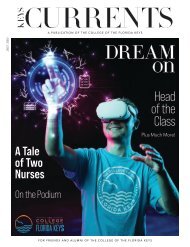CFK Keys Currents-2020-21
Keys Currents is an annual publication of The College of the Florida Keys
Keys Currents is an annual publication of The College of the Florida Keys
Create successful ePaper yourself
Turn your PDF publications into a flip-book with our unique Google optimized e-Paper software.
Faculty Research
Clawing for Coral
From the desk of
Angelo Jason Spadaro, PhD
Assistant Professor,
Marine Science & Technology
Coral reefs are some
of the most beautiful
and biodiverse
ecosystems on the
planet. They only cover
~0.6% of the seafloor —
an area roughly the
size of Colorado — but
they harbor between
25% and 33% of all
marine species.
M
ore species occur on coral reefs than
just about any other type of habitat.
They protect our coastlines and provide
more than one billion people with food and
livelihoods. They give us oxygen to breath
and new medicines in the fight against
cancer and other diseases. Coral reefs are
inherently tied to the persistence of human
existence on planet Earth. Unfortunately,
however, coral reefs are in trouble.
Climate change, rising sea surface
temperatures, and ocean acidification are
all chronic global threats to corals. Add
to that, local and regional stresses such
as coastal nutrient pollution, endocrine
disruptors, anchor damage, groundings,
overfishing, marine diseases, increasingly
destructive hurricane seasons, and many
others… and the fate of coral reefs becomes
increasingly uncertain. In fact, coral
reef ecology has become an often bleak
and depressing field of study. Imagine
watching the ecosystems you have grown
up admiring, and even dedicated your
professional life to studying, rapidly
deteriorate amid a fusillade of humaninduced
insults — not fun. What does a
degraded coral reef ecosystem look like?
Unfortunately, here in the Florida Keys, all
we need to do to answer that question is
visit our backyard.
The Florida Reef Tract — the third
largest barrier reef system on the planet
– has undergone a steep decline over the
last half-century. Unfortunately, that trend
has only worsened. Numerous groups,
including Mote Marine Laboratory, the
Coral Restoration Foundation, the Florida
Keys National Marine Sanctuary, The
Nature Conservancy, the Florida Fish
and Wildlife Conservation Commission,
and countless others are scrambling to
address the degradation of our iconic
coral reef ecosystems through restoration
and management. Typically, these
groups have focused heavily on “direct”
or “active” restoration which involves
planting live corals in places where they
once grew naturally — often referred
to as “gardening” corals. Indeed, much
of the theory behind coral restoration
comes from silviculture — the growing
and cultivation of trees. However, any
gardener knows that successful gardening
doesn’t stop when the trees are planted.
Both trees and corals compete with weeds.
In the sea, those “weeds” are algae. It may
have been some time since you’ve taken
a biology course, but we all know that
green stuff carries out photosynthesis and
photosynthesis is how we get oxygen, right?
Correct — photosynthesis takes carbon
dioxide and water molecules using sunlight
and produces simple sugars and oxygen
as byproducts. However, when you’ve got
too much photosynthesis going on and
not enough critters on the reef consuming
those sugars…bacteria, including all of the
nasty ones (and plenty that become nasty
when their numbers get out of control), are
able to bloom. What is normally a positive
or neutral relationship between corals
and microbes quickly shifts to a negative
interaction — those microbial communities
burn up the available oxygen stressing
corals which are then easy marks for the
increasingly abundant disease-causing
microbes. It’s a nasty cascade of bad news
for corals.
It's easy to say that algae are bad
for coral reefs, but that’s not entirely
true. Algae are essential to coral reef
communities. They’re among the most
important primary producers, they are
how coral reefs capture solar energy and
transmit it into the coral reef community.
Without them, coral reefs could not be
as diverse and abundant as they are.
Top photo: This large Elkhorn coral
(Acropora palmata) colony, located just off
the west end of Carrie Bow Cay in Belize, is
reminiscent of those that used to span most
of the reefs in the Keys and south Florida.
Inset photo: CFK Marine Science Professor
Dr. Angelo “Jason” Spadaro.
However, it’s a delicate balancing act.
On the one hand, you need enough critters
eating green stuff (herbivores) to keep
algae grazed — kind of like how you mow
your lawn and weed your garden to keep it
from being over-grown. But you also need
just enough nitrogen and phosphorous in
the water to keep algae going, but not so
much that they get out of hand — I’m sure
every gardener has over-fertilized their
lawn or garden at some point and seen
the weeds take advantage of it rather than
the plants it was intended for.
12 KEYS CURRENTS A PUBLICATION OF THE COLLEGE OF THE FLORIDA KEYS
A PUBLICATION OF THE COLLEGE OF THE FLORIDA KEYS KEYS CURRENTS 13





